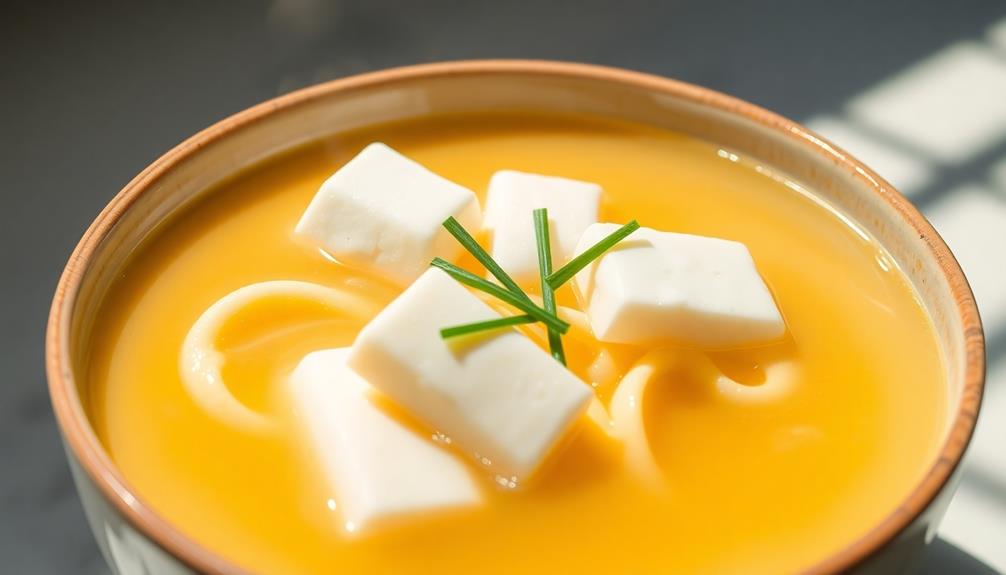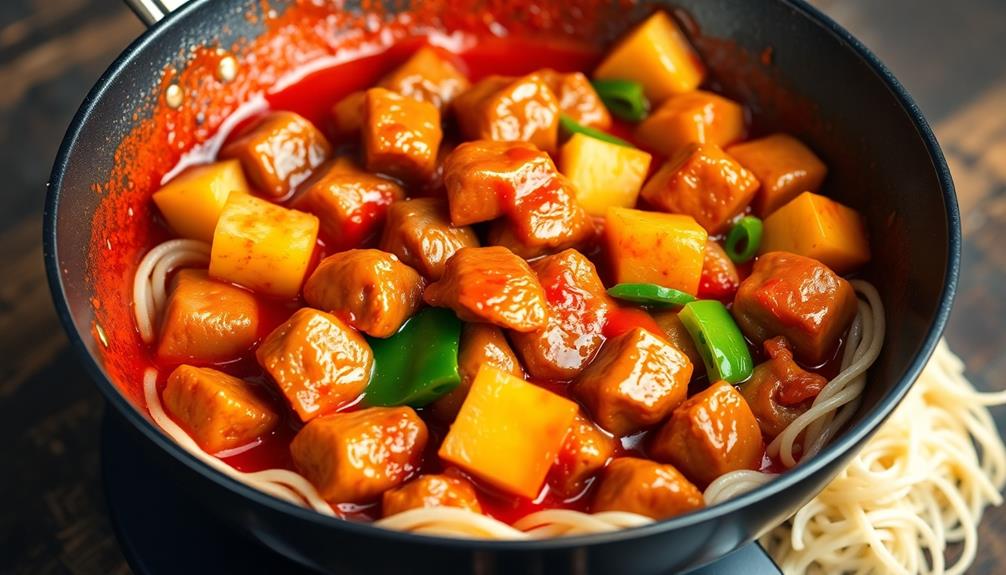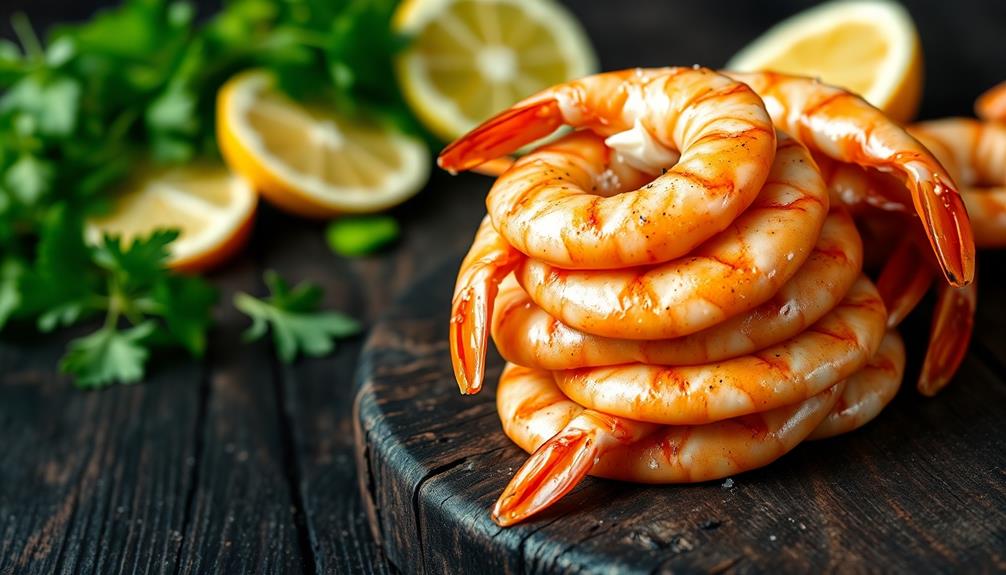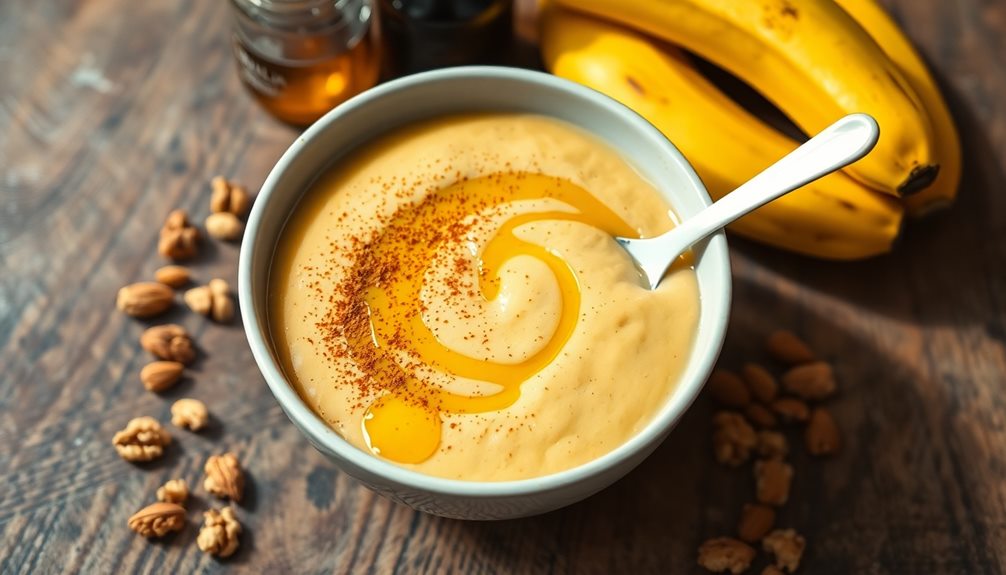Egg drop soup is an amazing Chinese dish you'll love! It all started centuries ago in imperial kitchens, where chefs crafted delicate ribbons of egg in a savory broth. Over time, this classic recipe evolved, adapting to different local ingredients. Today, you can enjoy this comforting soup with its key ingredients like broth, eggs, soy sauce, and green onions. The trick is slowly drizzling in the beaten eggs to create those lovely egg strands. It's simple to make at home, and you'll be amazed at how the flavors blend together. Want to learn more about the history and cooking techniques behind this beloved dish?
Key Takeaways
- Egg drop soup is a classic Chinese dish that combines savory broth with delicate strands of egg, showcasing culinary expertise.
- The key ingredients in egg drop soup are chicken or vegetable broth, eggs, cornstarch, soy sauce, sesame oil, and green onions.
- The traditional cooking technique involves slowly drizzling beaten eggs into the simmering broth to create the desired texture.
- Proper preparation, such as pouring the eggs slowly and stirring gently, is essential to achieve the ideal delicate and fluffy egg strands.
- Egg drop soup can be served as a starter or light main course and offers a range of nutritional benefits, including high protein from the eggs.
History
In ancient China, egg drop soup traces its origins to the Ming dynasty, where it was a staple dish among the imperial households. Back then, the imperial chefs would carefully crack eggs into hot broth, creating delicate ribbons that floated gracefully on the surface.
This simple yet elegant soup soon became a beloved favorite among the nobility, showcasing the ingenuity and culinary expertise of the time.
Over the centuries, the recipe has evolved and spread throughout China, adapting to local ingredients and preferences.
Today, egg drop soup is a beloved classic, enjoyed in homes and restaurants around the world. The process of slowly drizzling beaten eggs into hot broth remains the same, producing a comforting dish with a silky texture and delicate flavor.
Whether you're enjoying it as a starter or a light meal, egg drop soup continues to delight and nourish people from all walks of life.
Recipe
Egg drop soup is a classic Chinese dish that combines a savory broth with delicate strands of beaten egg. It's a comforting and nourishing soup that can be enjoyed as a starter or a light main course.
The key to a perfect egg drop soup is in the technique. The eggs should be gently incorporated into the hot broth, creating a delicate, cloud-like texture. This process requires a delicate touch and a bit of finesse, but the result is well worth the effort.
Ingredients:
- 4 cups chicken or vegetable broth
- 2 eggs, lightly beaten
- 2 tablespoons cornstarch
- 2 tablespoons soy sauce
- 1 teaspoon sesame oil
- Salt and white pepper to taste
- 2 green onions, thinly sliced
Instructions:
In a saucepan, bring the broth to a gentle simmer over medium heat. In a small bowl, whisk together the cornstarch and 2 tablespoons of the hot broth until smooth.
Slowly pour the cornstarch mixture back into the saucepan, stirring constantly, until the broth thickens slightly.
Slowly pour the beaten eggs into the hot broth in a circular motion, using a fork or chopsticks to gently stir and create delicate egg strands. Stir in the soy sauce and sesame oil, and season with salt and white pepper to taste.
Garnish the egg drop soup with the sliced green onions and serve hot.
Tips:
To achieve the best texture, it's important to pour the eggs into the broth slowly and gently. Avoid stirring the eggs too vigorously, as this can result in a more scrambled egg appearance.
Additionally, be sure to use a light hand when seasoning the soup, as the delicate flavors can easily be overpowered.
Cooking Steps
Crack those eggs into the beaten broth and let's get simmering!
Toss in some green onions for a pop of color and flavor.
As the pot bubbles away, you'll see the egg strands start to form – and that's when you'll want to season it all with a pinch of salt and pepper.
Step 1. Crack Eggs Into Beaten Broth
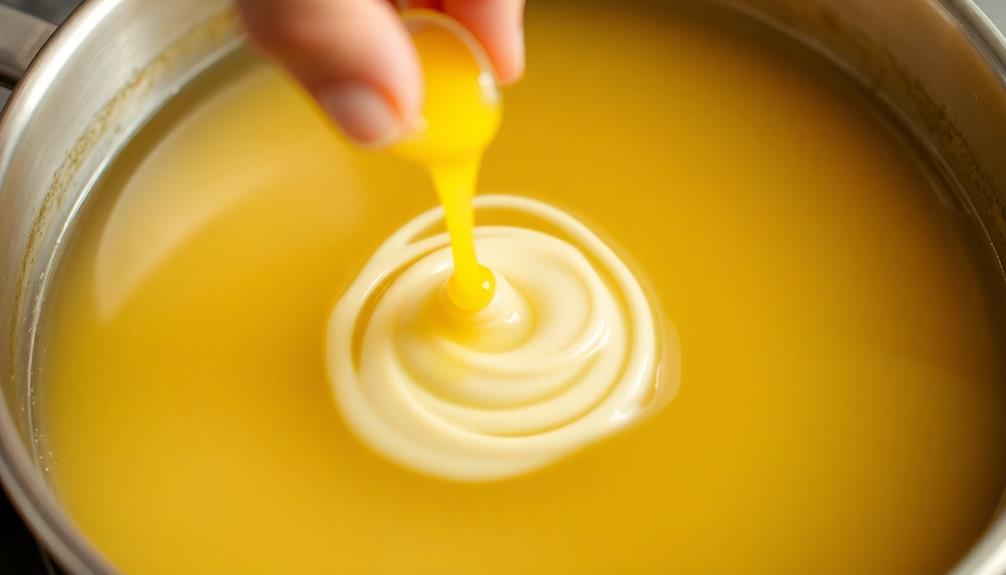
Next, you'll crack the eggs directly into the beaten broth. Gently crack each egg and let the contents slide right into the savory liquid. Be careful not to let any eggshells fall in! Once the eggs are in the broth, you can gently stir them in, making sure to maintain the creamy texture of the yolks. Then, let the eggs cook for a few minutes until they reach your desired level of doneness.
For a delicious addition to this savory soup, try serving it with a crispy scallion pancake recipe. The crispy scallion pancake recipe can be found on our website and is the perfect accompaniment to this egg drop soup.
As the eggs hit the hot broth, they'll instantly begin to cook, forming delicate strands throughout the soup. Stir the mixture gently with a spoon to help the eggs spread out and cook evenly. The eggs will cook quickly, so keep a close eye on them.
You'll know they're ready when the broth becomes slightly thickened and the egg strands are tender but still have a soft, fluffy texture. Once the eggs are cooked, your Egg Drop Soup is almost ready to serve! Just a few more steps to go before you can enjoy this savory, comforting dish.
Step 2. Add Green Onions

Slice the green onions into thin rings, reserving the white and green parts separately. The white parts have a more mellow flavor, while the green parts add a burst of freshness. Toss the white parts into the beaten egg broth, letting them gently cook for about a minute. This allows their subtle taste to infuse the soup.
Next, sprinkle in the vibrant green rings. Watch them swirl and dance as they hit the hot liquid, instantly brightening up the dish with their cheerful color. The green onions not only look fantastic, but they also contribute a zesty, aromatic note that complements the savory egg perfectly.
Be sure to give the soup a gentle stir, so the green onions are evenly distributed. Their delicate texture will add a lovely crunch to each spoonful.
With the green onions incorporated, your egg drop soup is nearly ready to serve!
Step 3. Simmer Until Egg Strands Form
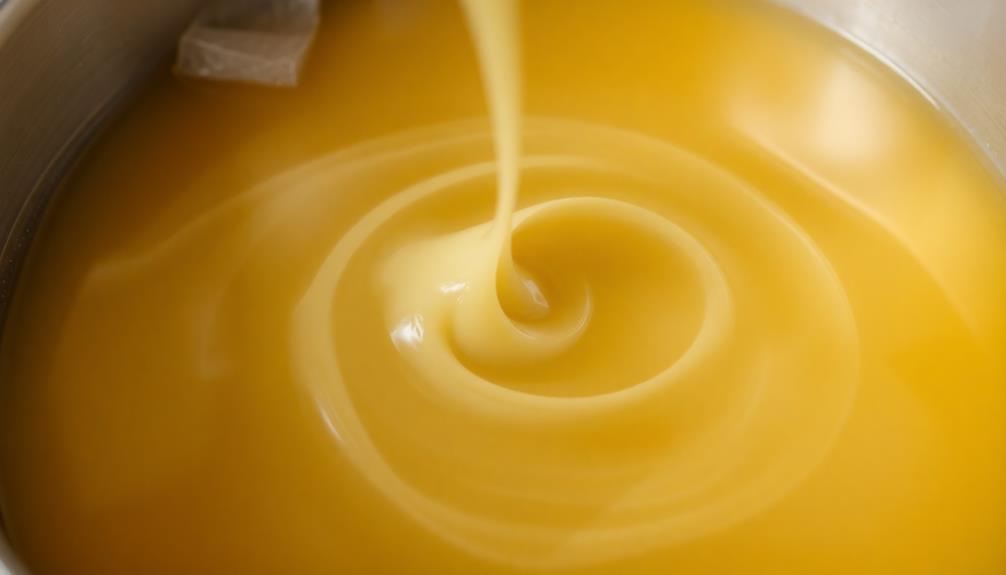
Once the white parts of the green onions have gently cooked for about a minute, it's time to slowly pour the beaten eggs into the simmering broth.
You'll want to do this in a steady stream, stirring the soup constantly with your ladle or spoon. As the eggs hit the hot liquid, they'll start to transform into delicate, wispy strands.
Careful not to overstir, or you'll end up with scrambled eggs instead of the lovely, silky texture you're going for. Keep the heat at a gentle simmer, and the eggs will gradually form those beautiful, ribbon-like pieces that are so characteristic of egg drop soup.
It's a mesmerizing process to watch! Once the egg strands have fully formed, your soup is ready to serve.
Ladled into bowls, it'll make for a comforting and nourishing meal. The delicate egg adds a lovely richness, while the broth remains light and refreshing.
Enjoy every slurp-worthy bite!
Step 4. Season With Salt and Pepper
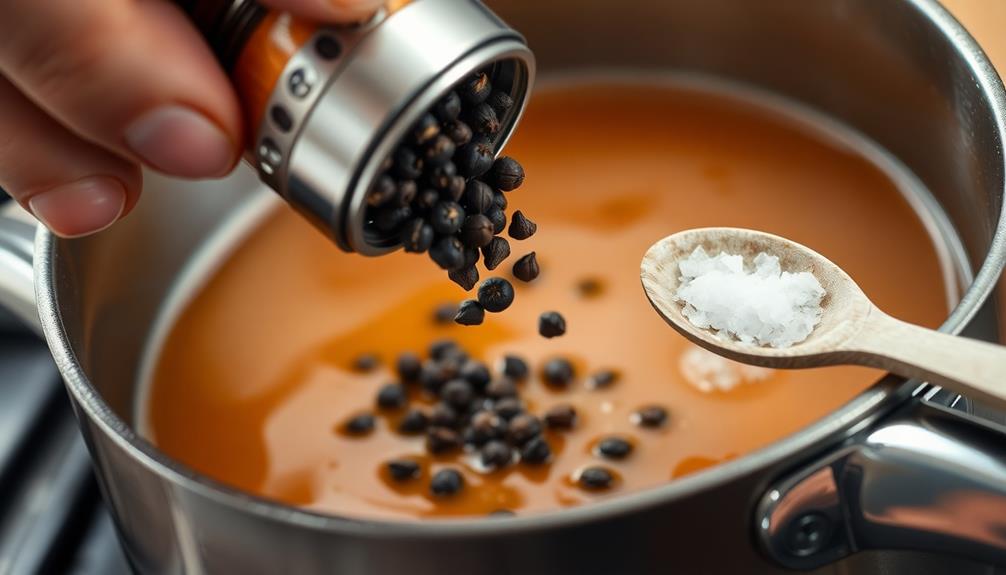
With the silky egg strands now beautifully formed, you'll want to season the soup to your taste. A pinch or two of salt will help enhance the flavors, bringing out the natural deliciousness of the broth.
Don't be shy – add a little at a time, stirring and tasting as you go, until the seasoning is just right. A few grinds of black pepper will also do wonders, adding a subtle kick and depth of flavor. The pepper's earthy notes will complement the rich, savory broth perfectly.
As you sprinkle in the salt and pepper, consider how important it's to create a personal budget to manage your cooking expenses effectively.
Give the soup a gentle stir to distribute the seasonings evenly. Now, take a moment to savor the aroma – isn't it magnificent?
With the seasoning complete, your egg drop soup is ready to serve and enjoy. Ladle it into bowls and get ready to delight your taste buds with each and every slurp.
Step 5. Drizzle in Beaten Egg

Gently drizzling the beaten egg into the simmering broth, you'll watch as delicate strands of egg begin to form. It's like magic!
With a slow, steady hand, let the egg drip in, creating those delicate, wispy ribbons that will float atop the soup. This is the moment that transforms a simple broth into the comforting, velvety Egg Drop Soup of your dreams.
As the egg cooks, it will thicken the broth slightly, creating a silky texture. Be sure to drizzle the egg in a circular motion, allowing it to gently disperse throughout.
Don't worry if the egg forms some larger pieces – that's all part of the charm! The key is to move slowly and resist the urge to stir too vigorously, which can break up the strands. As the eggs gently cook, you’ll notice the texture becoming creamy while still preserving those delightful ribbons of egg. This method is similar to egg tart traditional recipes, where the importance of delicate handling is key to achieving a smooth, custard-like consistency. Take your time, and you’ll be rewarded with perfectly tender eggs that melt in your mouth.
Once the egg is incorporated, your Egg Drop Soup is ready to serve. Ladle it into bowls and enjoy the delicate, eggy goodness in every spoonful.
Final Thoughts
Overall, how do you feel about the egg drop soup recipe? You should be feeling pretty good! This classic Chinese dish is easier to make at home than you might think.
By following the step-by-step instructions, you were able to create a delicious, comforting soup with a beautiful egg drop effect. The key was to slowly drizzle the beaten egg into the simmering broth, allowing it to gently form those lovely wispy strands.
Now that you've mastered the technique, you can experiment with different variations. Try adding extra vegetables like mushrooms or snow peas.
Or, for a heartier meal, stir in some cooked chicken or shrimp. No matter how you customize it, the end result will be a warming, nourishing soup that's perfect for an easy weeknight dinner or a comforting weekend lunch.
Frequently Asked Questions
What Is the Nutritional Value of Egg Drop Soup?
The nutritional value of egg drop soup depends on its ingredients, but it's generally a low-calorie, high-protein dish that's rich in vitamins and minerals. It can be a healthy option if you watch your sodium intake.
How Long Can Leftover Egg Drop Soup Be Stored?
Leftover egg drop soup can generally be stored in the refrigerator for 3-4 days. Be sure to store it in an airtight container, and reheat it thoroughly before serving to ensure food safety.
Can I Use a Different Type of Broth in the Recipe?
You can absolutely use a different type of broth in the recipe. Chicken, vegetable, or even beef broth would work well, adding their own unique flavors to the soup. Feel free to experiment and find the broth you enjoy most.
Is Egg Drop Soup Suitable for a Vegetarian Diet?
You can certainly adapt egg drop soup to accommodate a vegetarian diet. Simply substitute the chicken or beef broth with a flavorful vegetable broth, and you'll have a delicious, meat-free version of this classic dish.
How Can I Make Egg Drop Soup More Filling?
To make your soup more filling, try adding extra vegetables like mushrooms, spinach, or tofu. You can also add cooked grains like quinoa or brown rice. Top it off with some crunchy crackers or croutons for added texture.
